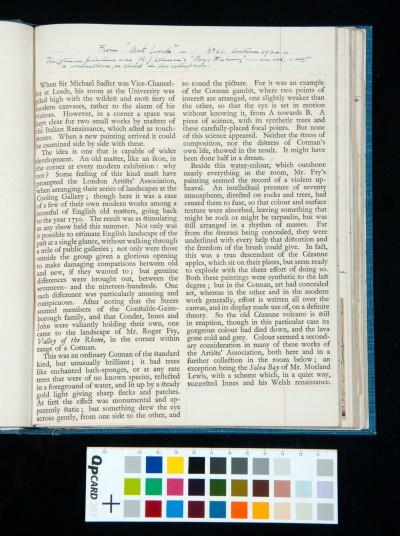Cotmania. Vol. VI. 1930-31
Archive: SDK Sydney Decimus Kitson Archive
Reference Number: SDK/1/2/1/6
Page: 36 recto
-
Description
Excerpt from "Art Work", No. 23, Autumn 1930
Excerpt from "Art Work", No. 23, Autumn 1930
Date: 1930-31
-
Transcription
From "Art Work". No. 23 Autumn 1930.
The Cotman picture was R. J. Colman's 'Boys Fishing', an oil, & not
a watercolour, as stated in the letterpress.When Sir Michael Sadler was Vice-Chancellor at Leeds, his room at the University was piled high with the wildest and most fiery of modern canvases, rather to the alarm of his visitors. However, in a corner a space was kept clear for two small works by masters of the Italian Renaissance, which acted as touchstones. When a new painting arrived it could be examined side by side with these.
The idea is one that is capable of wider development. An old master, like an ikon, in the corner of every modern exhibition: why not? Some feeling of this kind must have prompted the London Artists' Association when arranging their series of landscapes at the Cooling Gallery; though here it was a case of a few of their own modern works among a roomful of English old masters, going back
to the year 1750. The result was as stimulating
as any show held this summer. Not only was
it possible to estimate English landscape of the
past at a single glance, without walking through
a mile of public galleries ; not only were those
outside the group given a glorious opening
to make damaging comparisons between old
and new, if they wanted to; but genuine
differences were brought out, between the
seventeen- and the nineteen-hundreds. One
such difference was particularly amusing and
conspicuous. After noting that the Steers
seemed members of the Constable-Gainsborough family, and that Condor, Innes and
John were valiantly holding their own, one
came to the landscape of Mr. Roger Fry, Valley of the Rhone, in the corner within range of a Cotman.
This was an ordinary Cotman of the standard
kind, but unusually brilliant ; it had trees like enchanted bath-sponges, or at any rate trees that were of no known species, reflected in a foreground of water, and lit up by a steady
gold light giving sharp flecks and patches.
At first the effect was monumental and apparently static; but somehow drew the eye
across gently, from one side to the other, and
so round the picture. For it was an example
of the Cotman gambit, where two points of
are arranged, one slightly weaker than
the other, so that the eye is set in motion
without knowing it, from A towards B. A
piece of science, with its synthetic trees and
these carefully-placed focal points. But none
of this science appeared. Neither the stress of
composition, nor the distress of Cotman's
own life, showed in the result, It might have
been done half in a dream.Beside this water-colour, which outshone nearly everything in the room, Mr. Fry's painting seemed the record of a violent upheaval. An intellectual pressure of seventy atmospheres, directed on rocks and trees, had caused them to fuse, so that colour and surface texture were absorbed, leaving something that might be rock or might be tarpaulin, but was still arranged in a rhythm of masses. Far from the stresses being concealed, they were underlined with every help that distortion and the freedom of the brush could give. In fact this was a true descendant of the Cézanne apples, which sit on their plates, but seem ready to explode with the sheer effort of doing so. Both these paintings were synthetic to the last degree ; but in the Cotman, art had concealed art, whereas in the other and in the modern work generally, effort is written all over the canvas, and its display made use of, on a definite theory. So the old Cézanne volcano is still in eruption, though in this particular case its gorgeous colour had died down, and the lava gone cold and grey. Colour seemed a secondary consideration in many of these works of the Artists' Association, both here and in a further collection in the room below; an exception being the Solva Bay of Mr. Morland Lewis, with a scheme which, in a quiet way, suggested Innes and his Welsh renaissance.
